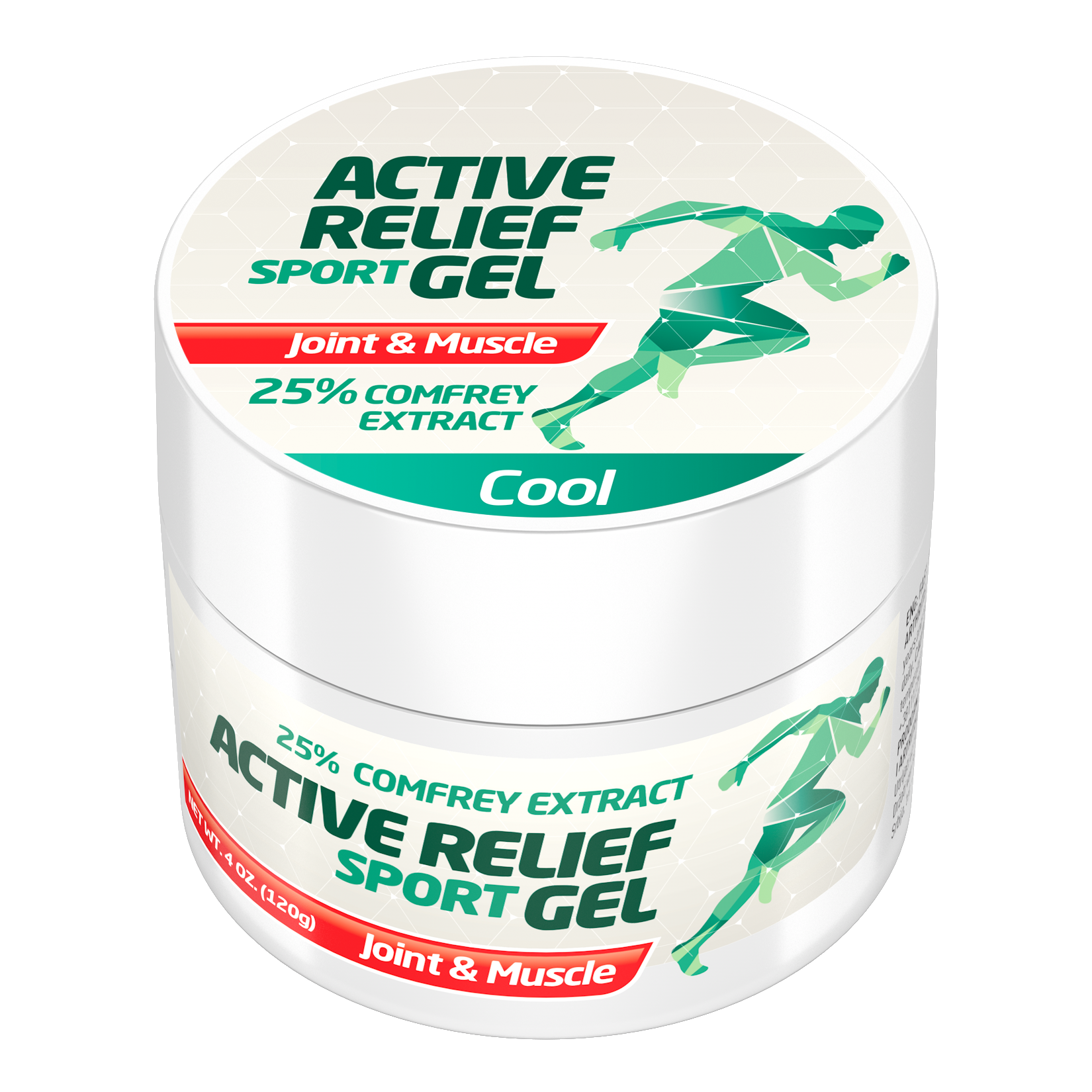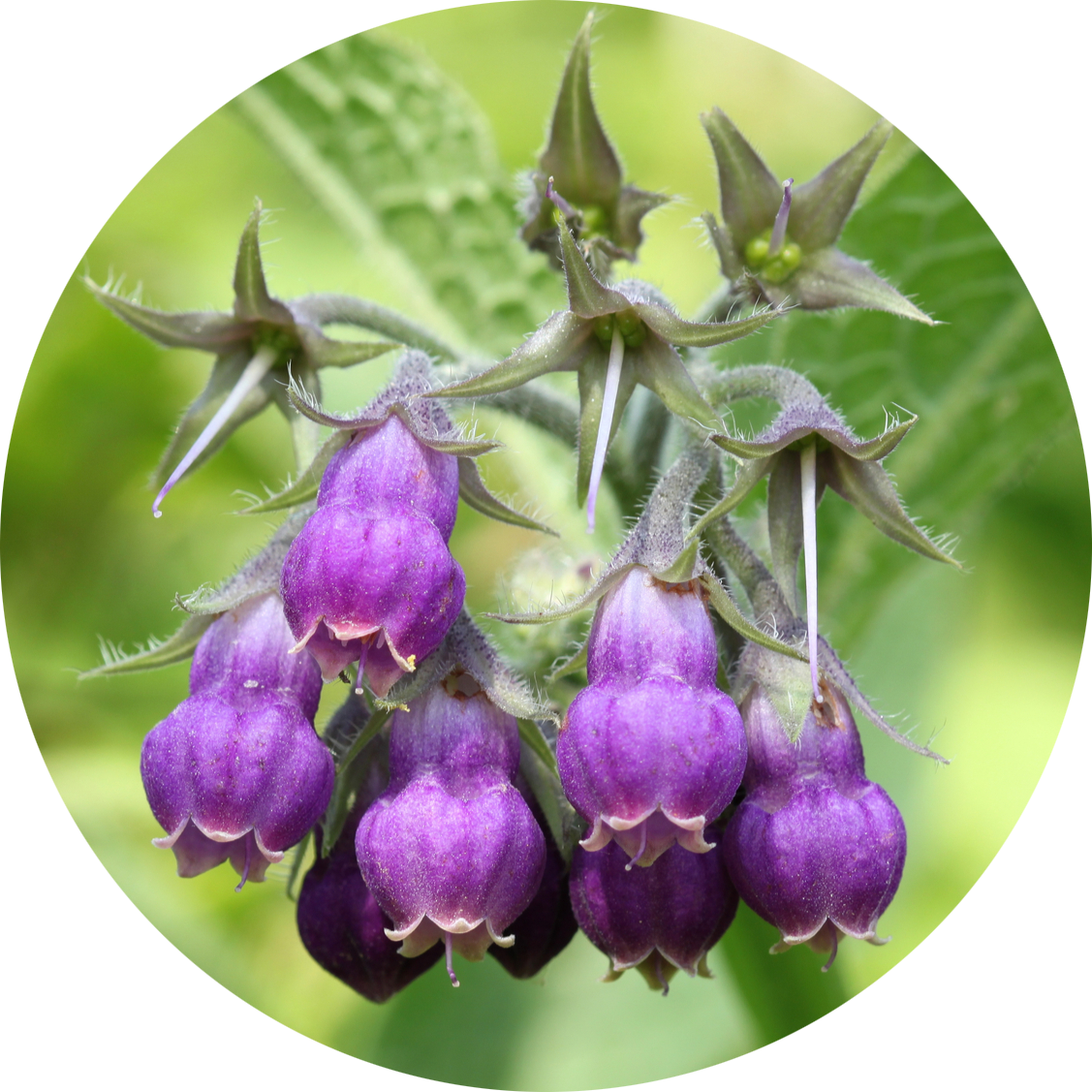(Symphytum officinale)
If there is a plant that has perfect pharmacodynamics and pharmacokinetics properties, then it is comfrey. Its action is well known in folk medicine and scientific research has confirmed its incredible efficacy and ability to tackle the very core of the problem. The best example of this is the fact that comfrey extract applied externally penetrates so deep into the tissue, all the way to the bones, that it helps with fractures by promoting healing. In English its name originates from the Latin confirmare – to connect, precisely because of its traditional use in healing fractures. That these are not superstitions has been proven by modern research.
WHAT DOES COMFREY LOOK LIKE?
Symphytum officinale is a perennial plant native to Europe, from where it has spread to the Far East and to the North American continent. Its cute, curved bell-shaped flowers attract bumblebees that pollinate them; its elongated, hairy leaves grow on the succulent stem up to 100 cm in height. The most medicinal part of comfrey is its root. It is deep, spindle-shaped and well-branched, and when its dark surface is cut, a pale interior is revealed. Although this deep and strong root is the reason why comfrey is often considered an unpleasant weed, the plant can be made into an excellent fertiliser as it is very rich in minerals. Comfrey seeks moisture, so we can often see it growing along ditches and streams; today, it is increasingly cultivated for medical and cosmetic use. It is harvested or dug in the spring and autumn, its root is cut and dried and a tincture is made from it, which can then be used in various preparations.
MEDICINAL PROPERTIES
As is the case with all medicinal plants, one needs knowledge and skill to use comfrey properly. Although it has been used in popular medicine to treat a number of disorders, from stomach issues to coughs and painful menstruation, one should beware of its alkaloids, which can damage the liver. When used externally, it is completely harmless and very therapeutic. Our ancestors used to chop its leaves and root and apply it to painful areas affected by bone ache, arthritis, gout and as first aid for injuries, sprains, swellings and fractures. Comfrey is effective in all types of external swellings, from varicose veins, through haemorrhoids to insect bites. Its soothing and hydrating effect also has an aesthetic effect, so it is increasingly used as an ingredient in cosmetic preparations for tightening facial skin and soothing wrinkles, and preparations for treating psoriasis.
What is so therapeutic about comfrey? The plant itself is rich in vitamins and minerals, but there are also essential oils, glycopeptides, amino acids and saponins that soothe inflammation and have antimicrobial action, as well as acids: oleanolic, lithospermic, chlorogenic, caffeic and rosemary, famous antioxidants. Comfrey also contains pyrrolizidine alkaloids which, when used properly, even have anticancer properties.
But the most important ingredient in comfrey that even has the ability to promote bone healing is allantoin. This diureid of glyoxylic acid is present in high concentrations in the embryos of most mammals, except in humans and higher primates, and it helps expel harmful substances. As such, it plays a major role in the metabolism in both animals and plants. Today, we know that its biggest source is comfrey; it is chemically synthesised from this plant and is widely used in cosmetics and medicine. Today, allantoin is found in toothpastes, shampoos, make-up, creams, as well as balms and gels for treating injuries to the skin, muscles and tendons. Allantoin has keratolytic, hydrating and soothing properties; applied externally, it soothes irritations and protects cuts, abrasions and burns from infections, it relieves redness, itching and flaking, even in serious skin disorders such as psoriasis. Allantoin penetrates deep through the skin, stimulates the growth of new cells, both on the surface and deep in the tissues and bones. By stimulating granulation, it even promotes the healing of bone fractures.
TOP PLANT FOR BONE ACHE
The healing properties of comfrey are known to all who suffer from chronic pain. In rheumatism, sciatica and disc herniation, there are very long painful episodes caused not only by poor posture but also muscle spasms. What can help is to warm the sore area and thus increase blood circulation. This is where comfrey enters the scene; in these disorders it is ideal in combination with capsaicin, an extract of hot pepper that gives a pleasant feeling of warmth.
COMFREY AND INJURIES
In acute pain which is caused by injuries, strains, sprains of ligaments, fractures, bruises, as well as those caused by arthritis, the swelling of joints and tissues, comfrey is best combined with ingredients that give a cooling effect – menthol and camphor. Camphor causes cold-warm sensations thus contributing to improved circulation.
In that combination, it is especially useful for athletes who have frequent injuries such as contusions or ligament strains, so it is recommended for use by sports therapists.
Today, many studies have proven the effectiveness of comfrey to soothe pain: in osteoarthritis, it definitely soothes aches and the feeling of stiffness in the joints, it has excellent analgesic effect in neuropathic back pain, in rheumatoid arthritis and its effect on tissue regeneration by promoting collagen production and reducing inflammation at the cellular level has been proven; this is why it is an ideal ingredient in preparations for facial and problematic skin care.
Comfrey is the main ingredient of two preparations produced in Herba Svet laboratories: Comfrey gel – Cool is there to help us with acute pain in muscles and joints, sports injuries, tendon and ligament sprains, swellings and arthritis, and Comfrey cream – Hot whose composition contributes to the relief of chronic pain in rheumatism, muscle spasms and poor circulation. Both gels also contain essential oils of lavender and rosemary, something that produces an aromatherapeutic effect that further soothes aches.


